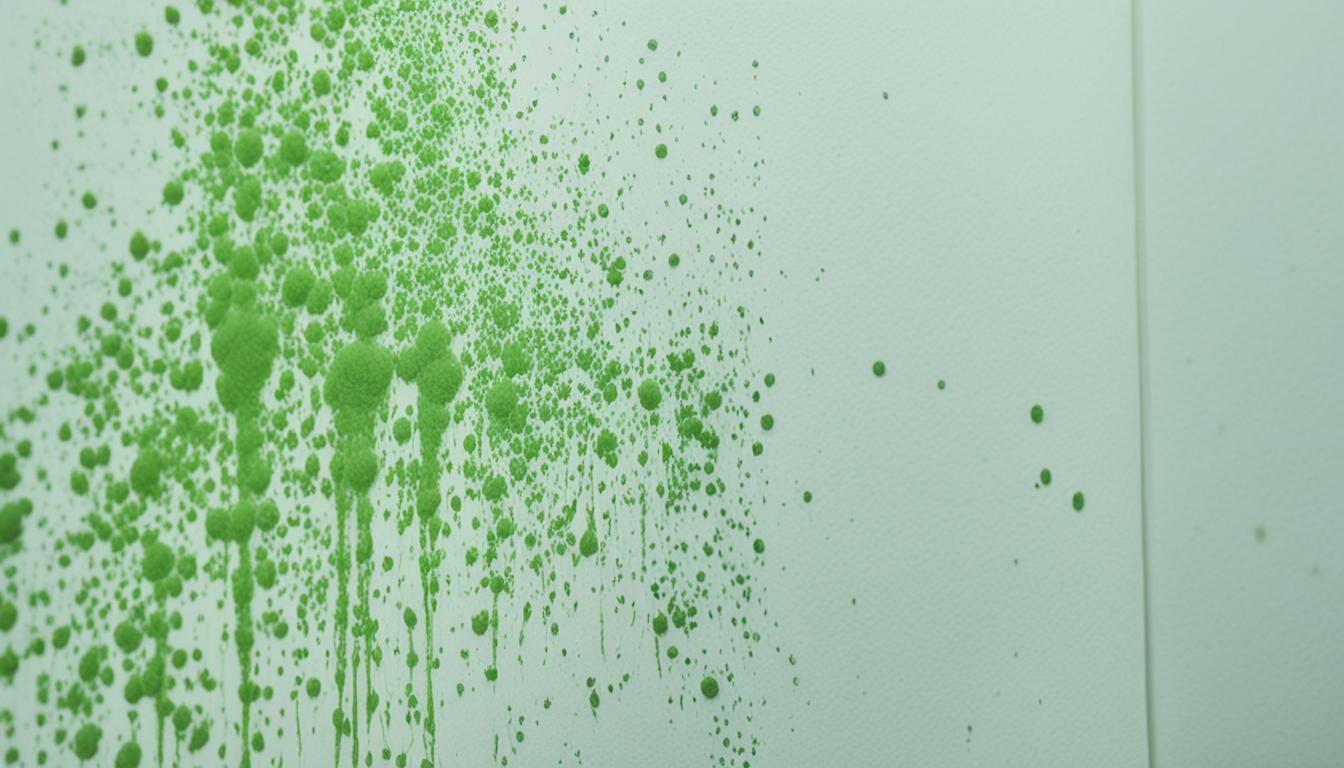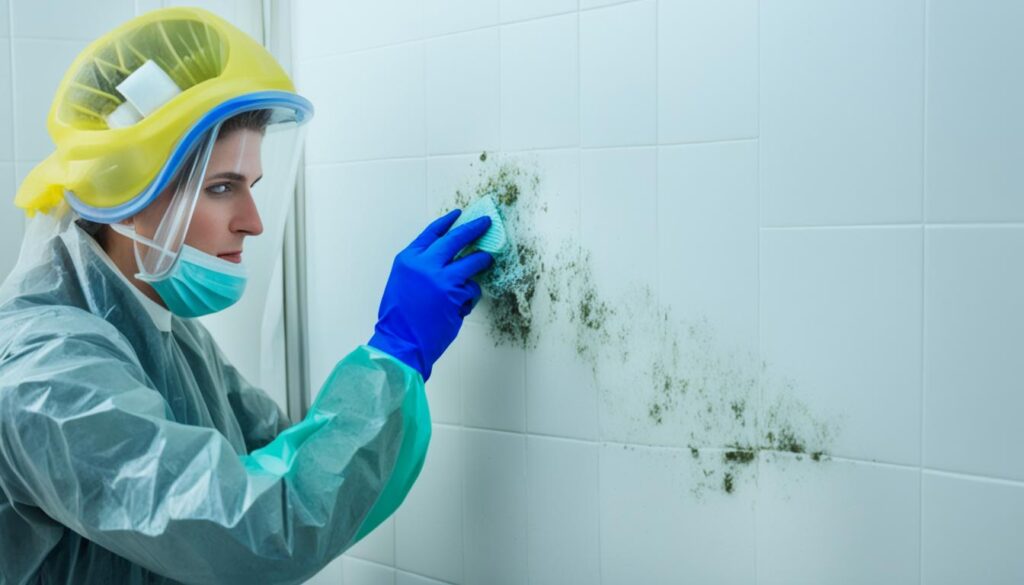
Mold Removal Guide: How to Clean Up Mold Safely
Welcome to our comprehensive guide on safely cleaning up mold in your home. Dealing with mold can be a daunting task, as it not only poses health risks but can also cause damage to your property. It’s crucial to approach mold removal with caution and follow proper procedures to ensure the safety of yourself and your loved ones. In this guide, we will provide expert tips and step-by-step instructions on effectively removing mold while minimizing its impact on your health and property.
Key Takeaways:
- Proper mold removal is essential to protect your health and property.
- Approach the cleanup process with caution and follow safety guidelines.
- There are natural and chemical-based methods available for mold removal.
- Prevention is key in avoiding mold growth in the future.
- Seek professional assistance for extensive mold problems or uncertainties.
Effective Methods for Mold Removal
In this section, we will explore different methods for effectively removing mold from your home. Mold can be a persistent and harmful problem, so it’s important to tackle it with the right techniques. Whether you prefer natural remedies or commercial mold removers, we have you covered with proven solutions to eliminate mold from your surroundings.
Natural Remedies
If you prefer using household ingredients and eco-friendly methods, natural remedies can be highly effective in tackling mold. Here are some natural methods you can try:
- Use vinegar: The acidic nature of vinegar makes it an excellent natural mold killer. Dilute white vinegar with water and spray it onto the affected areas. Leave it for a few hours, then scrub and wipe the mold away.
- Try hydrogen peroxide: Hydrogen peroxide is a powerful antifungal and antibacterial agent that can eliminate mold. Mix equal parts of hydrogen peroxide and water, spray it onto the moldy surface, and let it sit for 10 minutes before scrubbing.
- Apply tea tree oil: Tea tree oil has natural antifungal properties. Mix 10 drops of tea tree oil with one cup of water and spray it onto the mold. Allow it to sit overnight, and then clean the area the next day.
Chemical-Based Solutions
If you prefer commercial mold removers, there are numerous effective products available in the market. These solutions are specifically formulated to eradicate mold and prevent its regrowth. Here are some chemical-based methods:
- Use chlorine bleach: Mix one part chlorine bleach with three parts of water and apply it to the moldy surface. Allow it to sit for 15 minutes, then scrub and rinse thoroughly. Use caution when handling bleach and ensure proper ventilation.
- Try mold killing sprays: Mold killing sprays contain powerful ingredients that effectively eliminate mold. Follow the instructions provided on the product label for proper usage and safety precautions.
- Consider using mold foggers: Mold foggers release a fine mist that reaches every nook and cranny, effectively killing mold spores. Follow the manufacturer’s instructions and take appropriate safety measures when using foggers.
Remember, whether you choose natural remedies or chemical-based solutions, always wear protective gear such as gloves, goggles, and a mask to shield yourself from mold spores and harmful chemicals.
Now that we’ve discussed different effective methods for mold removal, it’s essential to follow the appropriate step-by-step instructions for each method to maximize their effectiveness. Below is a table summarizing the steps involved in each method:
| Natural Remedies | Chemical-Based Solutions |
|---|---|
| 1. Mix vinegar with water | 1. Mix chlorine bleach with water |
| 2. Spray the mixture onto the mold | 2. Apply the bleach solution to the mold |
| 3. Leave it for a few hours | 3. Let it sit for 15 minutes |
| 4. Scrub and wipe the mold away | 4. Scrub and rinse thoroughly |
By following these steps, you can effectively remove mold and restore a clean and healthy environment in your home.

Prevention and Long-Term Solutions
Prevention is the key to combating mold growth in your home. By taking proactive measures, you can create a healthy and mold-free environment for you and your family. In this section, we will delve into effective strategies for preventing mold from recurring and provide long-term solutions to ensure a lasting mold-free home.
Controlling Humidity Levels
Mold thrives in damp and humid conditions, making moisture control essential in mold prevention. To minimize the risk of mold growth, maintain the humidity levels in your home below 50%. You can achieve this by utilizing dehumidifiers, properly ventilating areas prone to moisture accumulation (such as bathrooms, kitchens, and basements), and promptly fixing any plumbing leaks or water damage.
Fixing Underlying Moisture Issues
Mold often occurs as a result of underlying moisture issues in your home. It’s crucial to identify and address these issues to prevent mold from taking hold. Inspect your home for any signs of water intrusion, such as leaks, condensation, or dampness. Repairing damaged roofs, gutters, pipes, and foundations can help eliminate potential sources of moisture and reduce the risk of mold growth.
Maintaining Proper Ventilation
Good ventilation plays a vital role in mold prevention as it helps to circulate air and reduce moisture build-up. Ensure that your home has adequate ventilation by using exhaust fans in bathrooms and kitchens, opening windows regularly to promote airflow, and utilizing air purifiers or air conditioning units with built-in filtration systems. These practices can help remove excess moisture from the air and discourage mold growth.
Regular Inspections and Maintenance
Prevention is an ongoing process, and regular inspections and maintenance are essential to keep your home mold-free in the long term. Inspect areas prone to moisture, such as basements, crawl spaces, and attics, for any signs of water damage or mold growth. Implement a routine maintenance schedule that includes cleaning and drying these areas, as well as replacing any worn-out seals or insulation.
“Prevention is not only better than cure, but it is also far more cost-effective in the long run. Taking proactive measures to prevent mold growth will save you from the hassle and expenses of mold removal and potential health issues.”
Long-Term Solutions
While prevention is crucial, it’s also essential to implement long-term solutions to maintain a mold-free environment. Consider the following practices:
- Use mold-resistant building materials when renovating or constructing your home. These materials are designed to resist mold growth and can provide added protection.
- Ensure proper drainage around your home’s foundation to prevent water accumulation and seepage into the basement or crawl space.
- Regularly clean and maintain your HVAC system to prevent mold spores from circulating throughout your home.
- Keep indoor plants to a minimum, as their damp soil can contribute to increased humidity levels.
- Use mold-inhibiting paint or additives for areas prone to moisture, such as bathrooms and kitchens.
By implementing these long-term solutions alongside prevention strategies, you can significantly reduce the risk of mold growth and maintain a healthy living space for years to come.

| Prevention and Long-Term Solutions | Benefits |
|---|---|
| Controlling humidity levels | – Reduces moisture that promotes mold growth – Improves indoor air quality – Prevents health issues associated with mold exposure |
| Fixing underlying moisture issues | – Addresses the root cause of mold growth – Protects the structural integrity of your home – Prevents further water damage |
| Maintaining proper ventilation | – Allows for proper airflow and moisture control – Reduces condensation and dampness – Minimizes the risk of mold growth |
| Regular inspections and maintenance | – Early detection of mold or water damage – Timely repairs and preventive measures – Saves costs on extensive remediation |
| Long-term solutions | – Utilizes mold-resistant materials – Ensures proper drainage – Regular HVAC maintenance – Optimizes indoor environment |
Conclusion
In conclusion, mold removal is a crucial process that requires careful attention to ensure both safety and effectiveness. Mold can have detrimental effects on both your health and property, making it essential to take immediate action. By following the expert tips provided in this guide, you can confidently clean up mold in your home and minimize its impact.
Remember, prevention is key in maintaining a mold-free environment. Keeping humidity levels in check and addressing any underlying moisture issues is vital to prevent mold from recurring. Additionally, implementing long-term solutions and maintenance practices discussed in this guide will help you safeguard your home against future mold growth.
If you are facing an extensive mold problem or are unsure about the proper remediation procedures, it is highly recommended to seek professional assistance. Mold remediation experts have the knowledge, experience, and proper equipment to handle severe cases effectively. Together, we can create a clean and healthy living space for you and your loved ones, free from the harmful effects of mold.




